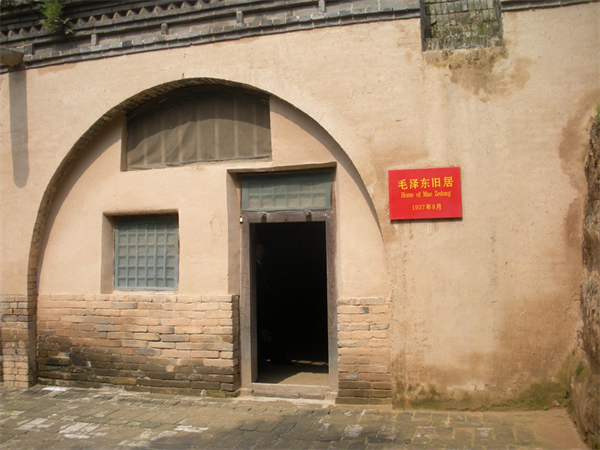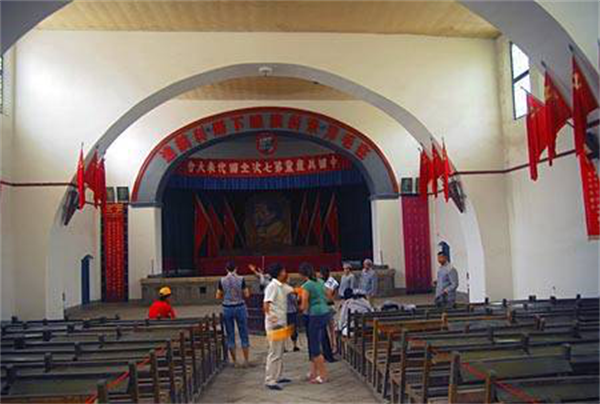- CURRENT LOCATION: HOME
- >> About Shaanxi
- >> History and Culture
- >>
- History of Shaanxi
The Red Holy Land for Revolution—Yan’an
2017-04-28 12:06:48 , Source : The Government Website of Shaanxi Province
Baota Hill in Yan’an
In October 1935, the Red Army, led by Mao Zedong, finished the arduous Long March and arrived at Wuqi Town in northern Shaanxi. It affected a junction with the northern Shaanxi Red Army led by Liu Zhidan. Wuqi, the place named after the famous military strategist (called Wu Qi) from the early Warring States Period, was recorded in history again as the place which witnessed the victorious end of a world-famous strategic shift and the glorious start of the 13-year course of the Chinese revolution in northern Shaanxi under the leadership of the CPC. On January 13, 1937, the CPC Central Committee was moved to Yan’an, which, from then on, became the command center for national liberation movements and the democratic revolutions, as well as the holy land worshipped by the masses. Since then, the pagoda (which was called “Baota” in Chinese), standing silently on the Qingliang Hill for hundreds of years, has become the permanent sign of the revolutionary holy land.
In Yan’an the CPC held a series of critical conferences which had impacts on China’s revolution and the national fate.

Luochuan Meeting Memorial
In December 1935, the CPC Central Committee convened the Meeting of the Political Bureau at Wayaobao in Zichang County. The meeting criticized the leftist mistakes with Wang Ming as representative and made arrangements for the Eastern and Western Military Expiditions. It also led to the military armistice agreements with the Northeast and Northwest Armies, and determined the political line of the anti-Japanese national united front.
On July 7, 1937, the outbreak of the Lugou Bridge Incident symbolized the beginning of the National Anti-Japanese War. On August 22, 1937, Mao Zedong, Zhu De, Zhou Enlai and others held an enlarged meeting of the CPC Central Committee Political Bureau in Fengjia Village, Luochuan County, Shaanxi. It was known as the Luochuan Meeting in history records. The meeting, held at a critical moment for the Chinese nation, made a comprehensive assessment of the KMT-CPC cooperation and the new situation after the main force of the Red Army was reorganized into the Eighth Route Army of the National Revolutionary Army. In addition, it determined to use all forces to strive for victory in the war, worked out the central tasks and action programs for the all-round Anti-Japanese War, and decided the strategic direction of independent bush fi ghting in the war.

The meeting hall of the Seventh National Congress
In September 1938, the CPC Central Committee held the Sixth Plenary Session of the Sixth CCP Central Committee in Fenghuang Mountain, Yan’an. This meeting was of great historical significance in determining China’s fate. The meeting correctly analyzed the situation of the Anti-Japanese War, formulated the CPC’s tasks during the new phase of the war, and made a comprehensive strategic plan for the CPC leadership in the war. It further defined the leadership of Mao Zedong in the CPC, and also for the first time made a proposal—all the party members must make great efforts to study Marxism-Leninism theory, be good at combining the general principles and international experience of Marxism-Leninism theory with the reality and the specific environment of China for the aim of achieving the localization of Marxism.
In April 1945, the Seventh National Congress of CPC was held at the Yangjialing Central Auditorium in Yan’an. It summarized the experience of the 20-year tortuous development history of China’s democratic revolution, and developed the correct lines, programs and strategies. The Congress corrected the erroneous ideas of CPC, so that the whole party reached unprecedented unity based on Marxism-Leninism and Mao Zedong Thought. The Seventh National Congress laid a solid political, ideological and institutional foundation for CPC guiding people to fight for the final victory of the war and the victory of the democratic revolution in the country.
In December 1947, the CPC Central Committee held an enlarged meeting in Yangjiagou of Mizhi County, know as the December Meeting. The December Meeting was held at the turning point of China’s revolutionary war. The meeting developed the CPC’s agenda for a national victory. This meeting marked the climax of the Chinese revolution.
In Yan’an, Mao Zedong not only wrote the popular poem “Snow · On the Pattern of Qinyuanchun”, but also engaged in a great theoretical creation, and wrote a series of program classics for guiding the Chinese revolution and construction. These included “On Practice, On Contradiction” completed in 1937, “On Protracted War”, “Problems of Strategy in Guerrilla War Against Japan”, “The Chinese Revolution and the Chinese Communist Party” in 1938, “On Coalition Government” in 1945, etc. Four volumes of “The Selected Works of Mao Zedong”, which were edited and published after 1949, collected a total of 158 articles, 112 of which were written during his stay in Yan’an, accounting for 70% of the book. In fact, most works completed in Yan’an are deliberations and solutions made by the leader for various international and domestic problems, as well as problems within the party at various historical stages. The problems cover overall theories and specific practices, macro-strategies and tactics, issues concerning the cooperation with and resistance against the KMT, and problems within the party. These deliberations and writings, deeply rooted in the soil of China, greatly enriched Marxism-Leninism, and made Mao Zedong’s unique contribution to the theory of Marxism-Leninism. From a large number of the works written by Mao Zedong while he dwelt in caves in Yan’an, it is not difficult to find that Chinese Marxism was conceived in the valley in northern Shaanxi. The lights of the dwelling caves in Yan’an illuminated the journey of the Chinese revolution, and the northwestern Loess Plateau was the highland of Mao Zedong Thought.

Site of Yangjiagou
In Yan’an, the CPC Central Committee also set up about four dozen colleges, such as the Chinese People’s Anti-Japanese Military and Political University, the Central Party School of the CPC, the Institute of Marxism-Leninism, the Northwestern Party School, the Northern Shaanxi Public School, China Medical University, the Eighth Route Army War College, the Eighth Route Army Military College, the Eighth Route Army Artillery School, Lu Xun Academy of Arts, the Shaanxi-Gansu-Ningxia Border Region Art Personnel School, Yan’an University, etc., which trained tens of thousands of military leaders and key technical personnel for the Chinese revolution. Meanwhile, national education, vocational education, and early childhood education policies were primarily developed in the Shaanxi-Gansu-Ningxia Border Region, which generally improved the cultural level of people in this area.
In Qingliang Mountain in Yan’an, the CPC also founded news organizations including the Xinhua News Agency, the Yan’an Xinhua Broadcasting Station, the Liberation Daily Office, and the Bordering-Area Mass Newspaper. Through news agencies, newspapers, and radio, the CPC transmitted its own ideals to the whole nation; through the English broadcasting section guided by an English friend Michael Lindsay, the CPC passed its own pursuits to the world. Nowadays, the Yan’an News Memorial in Qingliang Mountain is China’s only professional museum of news publishing, and Qingliang Mountain is hailed as the cradle of the Chinese news publishing industry.

Yan’an Revolutionary Memorial
In Yan’an, the CPC also established a pilot area for a new democratic society—the Shaanxi-Gansu-Ningxia Border Region, which commenced the rehearsal for the grand historic drama—the new democratic republic. In the same year, the secret observer Evans Carlson, sent by U.S. President Roosevelt, published two new books in which he objectively recounted his visit to Yan’an in 1938, and predicted with enthusiasm that Yan’an and the Border Region would be the “test tube” for a new China. In addition, many reporters who visited Yan’an also regarded it as a huge laboratory. As a steadily-growing force, people in Yan’an could beat the Japanese and govern the country. They foresaw China’s future from Yan’an. From the perspective of local governance, the Border Region was a model as the forerunner of the country’s democracy; it built a power system which had broader representation and could also strengthen the ruling of the CPC; this was considered a masterpiece. Because the democratic republic had been rehearsed and previewed on the Loess Plateau in Yan’an, the new China could be successfully cultivated in the trial fields of the Border Region, and important experience was accumulated which allowed the CPC to develop from local governance to overall governance.
Mao Zedong and the CPC spent nearly thirteen glorious years in northern Shaanxi. These thirteen years included the latter years of the Agrarian Revolutionary War, the entire period of the Anti-Japanese War and the early period of the Liberation War, accounting for almost half of China’s twenty-eight-year democratic revolution. During this important historical period, the Chinese revolution led by the CPC with Mao Zedong as its representative, experienced the historic turning point of developing from weak to strong, moving from low tide to high tide, and eventually won the great national victory.
Yan’an and the Shaanxi-Gansu-Ningxia Border Region was the foothold of the CPC Central Committee and the Red Army after the Long March. It was the headquarters of the Chinese revolution, the starting point and political guiding center of the Chinese people’s Anti-Japanese War, and the model trial field for the new democracy. In this region, Chinese Marxism-Leninism-Mao Zedong Thought, which not only embodies the basic principles of Marxism, but also contains the Chinese nation’s fine ideas and lessons learned from revolutionary practice, was developed, and eventually matured to become the party’s guiding ideology. In this region, the CPC also developed the Yan’an Spirit, which consists of the following contents: the fi rm and correct political orientation, the ideological line of emancipating the mind, seeking truth from facts, the fundamental purpose of serving the people wholeheartedly, and the enterprising spirit of self-reliance and hard work. Under the great banner of Mao Zedong Thought, the CPC led the people all over China to continue moving forward, from the starting point of the border region to the greater journey of national victory.

Government Organizations



Other Links

Copyright@www.shaanxi.gov.cn All Rights Reserved
Registration Number:陕ICP备10004160号
